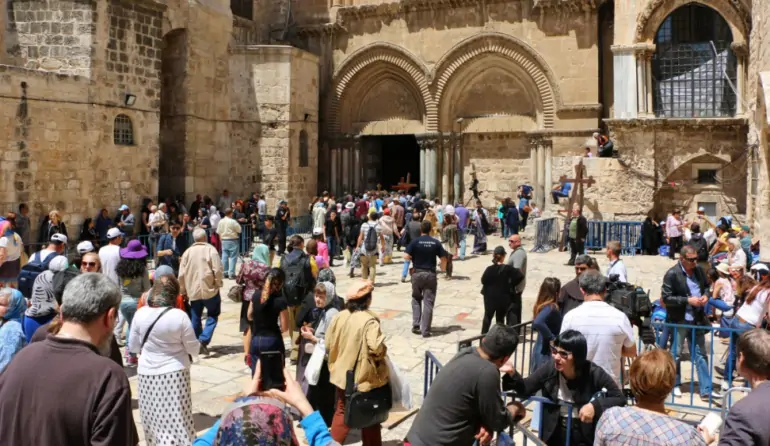
Jerusalem is central to the geography and events of the Hebrew Bible. The Hebrew Bible has, in various ways, exerted a profound influence on Judaism, Christianity and Islam.
Historically, Jerusalem became the capital of Israel by decree of King David 3,000 years ago, based on his understanding of God’s own choice.
According to 2 Chronicles 6:5-6 where King Solomon quotes God as saying,
“Since the day that I brought my people out of the land of Egypt, I chose no city in all the tribes of Israel in which to build a house, that my name might be there, and I chose no man as prince over my people Israel; but I have chosen Jerusalem that my name be there and I have chosen David to be over my people Israel.”
Since then, it has remained Israel’s capital. Even though other nations conquered and settled in, none ever declared Jerusalem as their capital.
“As far as God is concerned, Jerusalem has been the eternal, undivided capital since the reign of David,” said Laurie Cardoza-Moore. “God established the boundaries of all the nations, and he chose the city of Jerusalem for himself.”
Over the past 2,000 years, even during times of occupation and persecution, a Jewish community resided there and maintained it as their “eternal capital.”
What to do in the Biblical Capital
Old City
As its core is the Old City, a maze of narrow alleyways and historic architecture that characterizes its four quarters – Christian, Muslim, Jewish and Armenian. It is surrounded by a fortress-like stone wall and is home to some of the holiest sites in the world.
The Old City is home to many of Jerusalem’s most sought-after attractions, including the Western Wall, the Church of the Holy Sepulchre, and Temple Mount.
Originally built by King David in 1004 B.C., the walled Old City comprises four distinct areas: the Jewish Quarter, Cardo, the Muslim Quarter, the Christian Quarter, and the Armenian Quarter.
Each quarter exudes its unique atmosphere, with religious sites, shops, and food offerings reflecting its respective heritage.
Western Wall
The Western Wall, also known as the Wailing Wall or the Kotel, is the most significant historic site for the Jewish faith.
This wall, located in the heart of the Old City, is a remnant of King Herod’s renovation of the Second Temple and dates back to the first century B.C.
Millions of pilgrims, Jewish and non-Jewish, make their way to the Western Wall each year to pray, writing their wishes on small pieces of paper before placing them between the cracks in the stone for God to answer.
Between 587 B.C. and A.D. 70, Jews built two temples in Jerusalem to center their religious and communal life. Nearly 2,000 years later, Jerusalem and the Temple remain central to traditional Jewish thought and prayer.
The Church of the Holy Sepulchre
Believed by many to stand directly above Jesus Christ’s tomb, the Church of the Holy Sepulchre is considered one of the world’s holiest Christian sites.
Emperor Constantine originally built the church in 326 A.D. as a Byzantine place of worship. The Church has been destroyed twice, first by the Persians in 614 A.D. and then by the Egyptians in 1009. Today’s church is a product of 12th-century Crusaders.
Temple Mount
Temple Mount is one of the holiest sites in Jerusalem for both Jews and Muslims. Historians have associated it with Mount Moriah, where the binding of Isaac took place, and Mount Zion, where the original Jebusite fortress once stood; however, neither theory has been proven.
Jews believe that this section of the Old City is the resting place of the Divine Presence on earth and the source of the dust that God used to create Adam. Meanwhile, Muslims believe that Muhammad’s ascent to heaven took place at Temple Mount.
Even if you’re not a believer, travellers say that Temple Mount is worth visiting for its resounding historical significance.
Despite its importance to both religions, Temple Mount’s most notable feature is distinctly Muslim: the Dome of the Rock. Encased in this golden-topped structure is the rock where Muhammad prayed with Gabriel.
It is also said to be the exact location of his ascension. You should also visit the Al Aqsa Mosque, the third holiest place in Islam behind Mecca and Medina. Constructed in 720 A.D., Al Aqsa is described by many as one of the most beautiful mosques in the world.
The importance of the Biblical Capital
Aside from being the home to many important and religious sites, Jerusalem is Israel’s Biblical Capital because of its people, their faith, and devotion to the city.
Even tho it took some time for the rest of the world to consider it a capital, Jews never lost hope. For them, Jerusalem has always been the capital of Israel in their hearts.
In 1948, when the U.N. voted to partition Israel into Arab and Jewish states, Israel immediately reaffirmed Jerusalem as its capital and enshrined it in its national anthem, “Hatikvah,” “The Hope”:
“As long as within our hearts the Jewish soul sings, as long as forward to the east to Zion looks the eye, our hope is not yet lost. It is two thousand years old, to be free in our land, the land of Zion and Jerusalem.”
If you are interested in visiting these places, visit our website. Coral Tours provides the best biblical Israel and land tours for Christians looking for trips to Israel.
Coral Tours offers the best Israel and Christian bible tours.
Make sure to contact our operators to schedule your tour with us.
